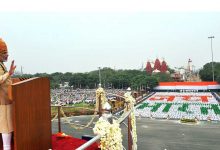 Technology promotes transparency, which has the potential threat to unmask shady zones and erode concentration of authority. Sadly, our system is very specially designed to abort the penetration of technology in the public sector. Thus, instead of being proactive for percolation of technology, the IT department – or any other departments – has been doing the best to retain obsolete practices. Disguised unemployment is cancer, opines Hemashri, in the weekly column, exclusively for Different Truths.
Technology promotes transparency, which has the potential threat to unmask shady zones and erode concentration of authority. Sadly, our system is very specially designed to abort the penetration of technology in the public sector. Thus, instead of being proactive for percolation of technology, the IT department – or any other departments – has been doing the best to retain obsolete practices. Disguised unemployment is cancer, opines Hemashri, in the weekly column, exclusively for Different Truths.
For Joyeeta, disguised unemployment was a strange phenomenon. People apparently employed might actually be unemployed. This concept was explained to her by the professor when she was an Economics Major student in a college. Disguised unemployment refers to the work area, where some employees have zero or almost zero marginal productivity. If such employees are removed, the total level of output remains the same. As an illustration, to bring clarity, the professor had given an example. Suppose in an agricultural field, 10 workers are working in 50 bighas of land and producing 100 kgs of paddy per bigha. Now, say, two more additional workers are engaged but the total output remains the same, which means marginal productivity of the two additional workers is zero. This is called disguised unemployment. In the agricultural sector of India, this is a common problem. This was one of the many concepts learnt in college textbooks. However, never in life, could Joyeeta imagine that this may be actually a profound syndrome to be witnessed where she would work to earn her bread.
Mahimamoyee Prodeep Das was a hardworking lady. Hardworking because she had been carrying a heavy load in the form of a hefty body that speaks of the abundance of nourishment. She was a habitual latecomer to work. Draped in costly attire, she had a soft voice that was well adapted to speaking sweetly, devoid of substance. She knew the art of management in many aspects often considered crucial for the survival of a government servant. First thing on her arrival in the office was to switch on WhatsApp, Facebook or the Messenger. She was techno-savvy in a special way that her expertise was merely confined to only these chatting channels. With great devotion, she started her day with a finger tapping on her smartphone. She was very conveniently located in a technical department, which was dysfunctional.
Technology promotes transparency which has the potential threat to unmask shady zones and erode concentration of authority. Sadly, our system is very specially designed to abort the penetration of technology in the public sector. Thus, instead of being proactive for percolation of technology, the IT department – or any other departments – has been doing the best to retain obsolete practices. The crucial decision making Apex Committee Meeting has not taken place for last three years and no one bothers. “Aaj nehi toh kaal, kaal nehi toh parsu, itna jaldi kya hein, jeena hein baarso!”(If not today then tomorrow, if not tomorrow then the day after, why rush things when we have to live for years!)
Happy Mahimamoyee after her engrossed chatting session either proceeded to her ever-expanding friend circle spread across various departments of the huge capital complex or else a delegation of her friends would arrive in her spacious well-equipped chamber. Endless chat over delicious snacks would keep them pleasantly engaged. Topics could be anything from fashion, children, next holiday destination to rumours of extramarital affairs of colleagues, etc.
Mahimamoyee has a costly computer printer, which she had never used because she was of the opinion that  writing was a clerical bastion. She did even waste words on her files. When it came to any form of written communication, she was on a strict austerity drive. She never wrote beyond, “Note above placed for approval,” with a few words here and there. Ignorance is bliss. She lived in that blissful world knowing nothing about the department, where she had been working for nearly a decade. She was a hot favourite with the Assistant brigade because she was totally dependent on them for every letter, every document and was over generous with her signature. Busy in her own world of food, fun, and fashion, she often signed without even looking at what was placed before her.
writing was a clerical bastion. She did even waste words on her files. When it came to any form of written communication, she was on a strict austerity drive. She never wrote beyond, “Note above placed for approval,” with a few words here and there. Ignorance is bliss. She lived in that blissful world knowing nothing about the department, where she had been working for nearly a decade. She was a hot favourite with the Assistant brigade because she was totally dependent on them for every letter, every document and was over generous with her signature. Busy in her own world of food, fun, and fashion, she often signed without even looking at what was placed before her.
Joyeeta discovered her unique style of functioning as a colleague. The contractual employees working cell were not getting their salary for five months and finally, they went on a strike. The whole team of the department went on a roadshow for an event so Joyeeta had to handle the crisis to fix it up. Following up the matter, she discovered to her utter surprise that for six months Mahimamoyee did absolutely nothing to address the issue except sending a one sentenced letter to the concerned agency. The lady officer of the nodal agency spoke harshly complaining of inaction and showed her that callous communication where even that one sentence had a repetition of words. Every time Joyeeta approached Mahimamoyee to discuss any issue as a junior, she found the lady to be completely unaware about things inspite of a decade-long presence in the department.
One day as Joyeeta entered her chamber, she found Mahimamoyee having an animated discussion on pay hike. She found the senior lady expressing her discontentment over such a nominal hike in the salary. Joyeeta was thinking wish we could have a system to evaluate and monitor the output of each employee. Joyeeta knew for sure there would be hordes of workers like Mahimamoyee who were surely disguisedly unemployed. Even if they were withdrawn from the system, the total output would remain the same.
The question is, what output the system produces or intends to produce? Can anyone define what output this mammoth system is designed to produce? The employees of a liquor company know their purpose is to  reduce costs and maximise production of liquor to earn and to sell to maximise profit hoping that at least a part of the profit shall be shared. Who defines output in a government set-up? Not to speak of vision or mission of this gigantic system, even what output it is meant to produce is not defined anywhere. So what these demotivated employees can be expected to do but spend time in mindless wandering. Joyeeta remembered those lines she read in The Algebra of Infinite Justice, by her favourite author Arundhati Ray, “Government in India is huge in size like a dinosaur but governed by a brain of the peanut size and when it moves its movement is not even discernible….”
reduce costs and maximise production of liquor to earn and to sell to maximise profit hoping that at least a part of the profit shall be shared. Who defines output in a government set-up? Not to speak of vision or mission of this gigantic system, even what output it is meant to produce is not defined anywhere. So what these demotivated employees can be expected to do but spend time in mindless wandering. Joyeeta remembered those lines she read in The Algebra of Infinite Justice, by her favourite author Arundhati Ray, “Government in India is huge in size like a dinosaur but governed by a brain of the peanut size and when it moves its movement is not even discernible….”
With the passage of time, Joyeeta realised things that she earlier treated as pure theory is actually so much relevant in real life. Who would define output or purpose in this system? When will it relate to a vision or the mission to see the bigger picture? Till a great messiah arrives, we all are cursed with a massive disguised unemployment. The workplace will remain ‘gossip parlours’ for the countless demotivated employees.
Why work when you could get paid for not working!
©Hemashri Hazarika
Photos from the Internet
#Government #Unemployment #Employee #GovernmentGallimaufry #DifferentTruths






 By
By
